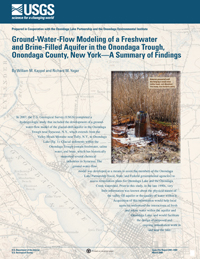Open-File Report 2007–1409

Prepared in cooperation with the
Onondaga Lake Partnership and the Onondaga Environmental Institute
This report is available as a printed product and in PDF Format (2.4 MB)
If you have Adobe® Acrobat® or Adobe ® Acrobat® Reader® installed on your computer, you may view and print the PDF version of this report. Acrobat Reader, is a free download from Adobe Systems, Inc. Users with disabilities can view information concerning accessibility at access.Adobe.com.
In 2007, the U.S. Geological Survey (USGS) completed a hydrogeologic study that included the development of a groundwater-flow model of the glacial-drift aquifer in the Onondaga Trough near Syracuse, N.Y., which extends from the Valley Heads Moraine near Tully, N.Y., to Onondaga Lake (fig. 1). Glacial sediments within the Onondaga Trough contain freshwater, saline water, and brine, which has historically supported several chemical industries in Syracuse. The ground-water-flow model was developed as a means to assist the members of the Onondaga Lake Partnership (local, State, and Federal governmental agencies) to assess remediation plans for Onondaga Lake and the Onondaga Creek watershed. Prior to this study, in the late 1990s, very little information was known about the physical nature of the valley-fill aquifer or the quality of water within it. Acquisition of this information would help local agencies understand the interactions of fresh and saline water within the aquifer and Onondaga Lake, and would facilitate the design of proposed and ongoing remediation work in and near the lake.
The USGS study characterized the geology and geochemistry of the aquifer system, estimated the rate and direction of ground-water movement, and estimated mass loadings of chloride to Onondaga Lake and its tributaries from natural and anthropogenic sources. The study required analysis of existing hydrogeologic data and drilling of new test wells to collect additional hydrogeologic data to supplement this database. A three-dimensional geologic model of the unconsolidated deposits that fill the Onondaga Trough was developed from this information. Water-quality samples were collected, and hydraulic head (water-level) measurements were made in the test wells. The water samples were analyzed for a variety of chemical constituents to determine the composition and age of saline waters within the aquifer. The geologic model, together with the water-quality and hydraulic-head data, supported the development of several variable-density flow models of the aquifer system. The complete results of this study are summarized in Yager and others (2007a), which discusses the present location of the brine pool, potential sources of the brine, and the effects of the brine pool on ground-water flow near Onondaga Lake.Kappel, W.M., Yager, R.M., 2008, Ground-water-flow modeling of a freshwater and brine-filled aquifer in the Onondaga Trough, Onondaga County, New York— A summary of findings: U.S. Geological Survey Open-File Report 2007-1409, 12 p.
For further information, contact:
Director
U.S. Geological Survey
New York Water Science Center
425 Jordan Road
Troy, NY 12180
Email: dc_ny@usgs.gov
Phone: (518)285-5600
Visit our web site: http://ny.water.usgs.gov